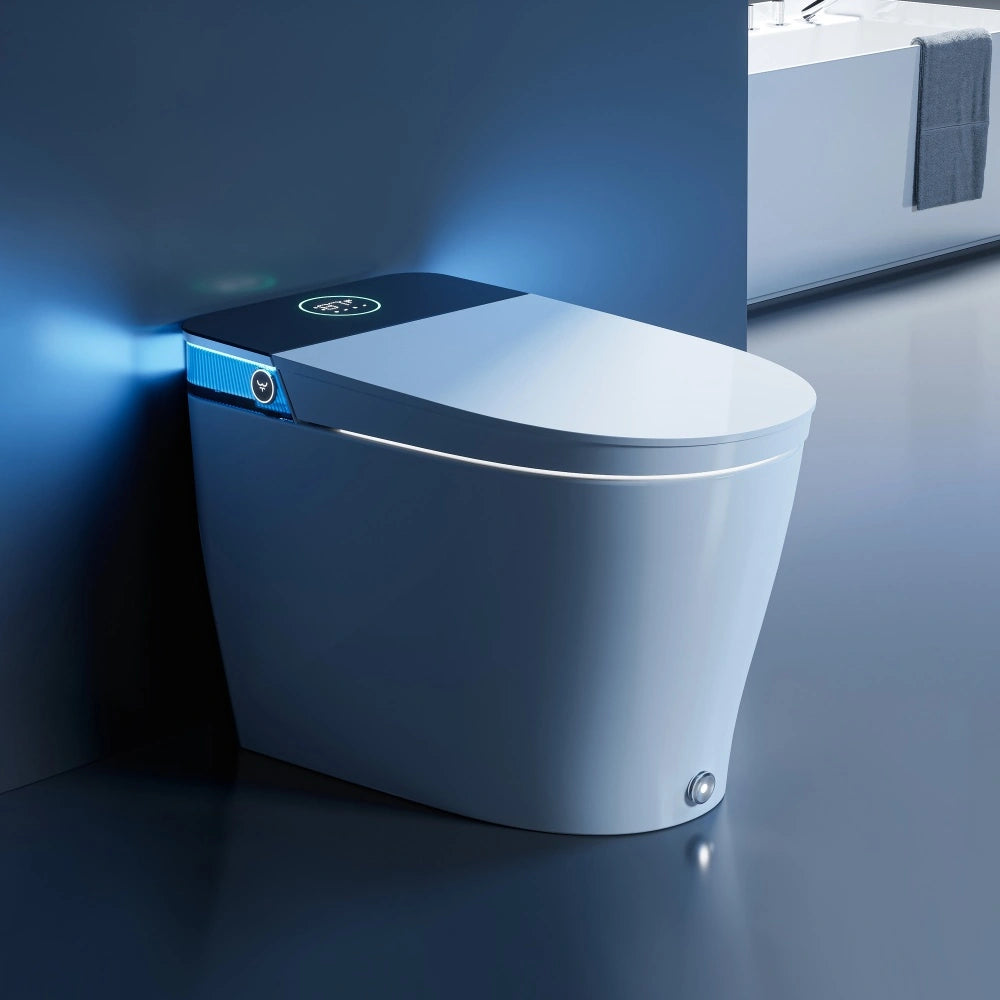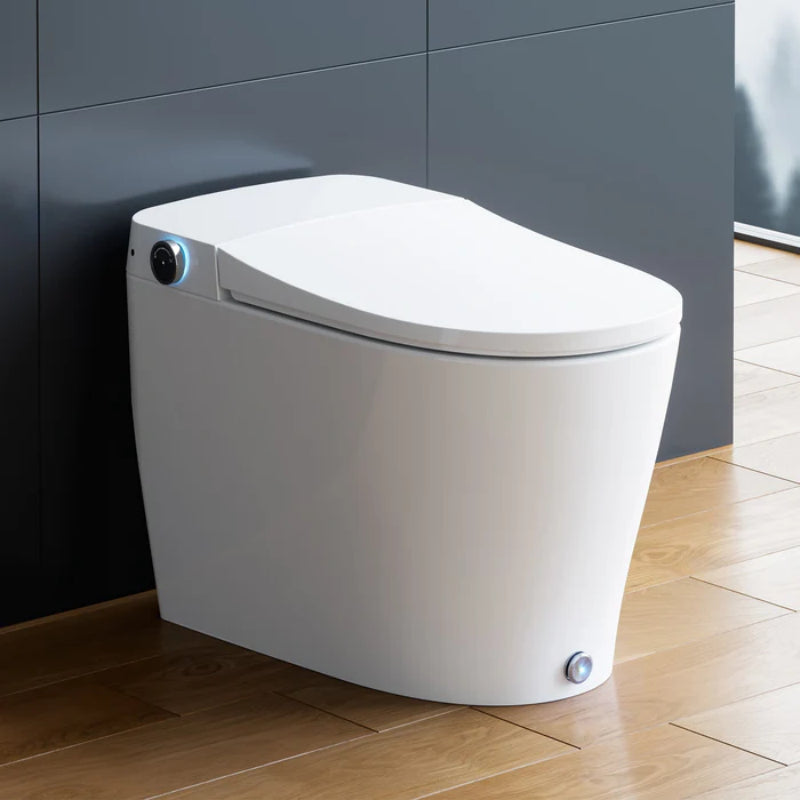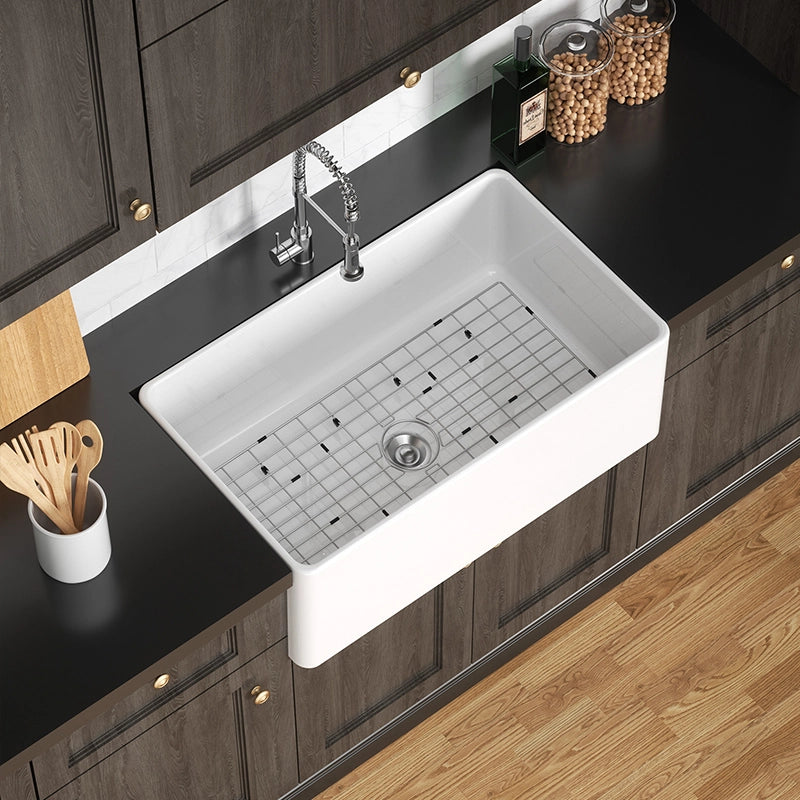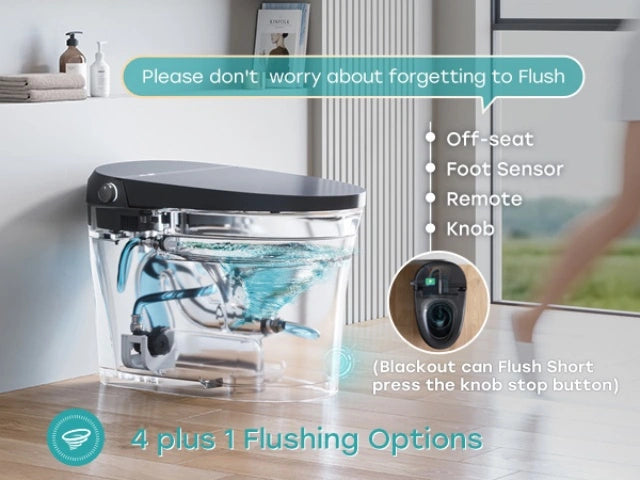When your toilet won’t flush and water just swirls in the bowl, it usually means a clog is to blame. Most people would instinctively reach for a plunger or already know how to use a toilet snake to handle the problem. But what if you don’t have either tool available?
That’s when knowing how to unclog a toilet without a plunger becomes incredibly useful. Luckily, with a few everyday household items—like hot water, baking soda, or even a wire hanger—you can still get things flowing again.
HOROW, a trusted toilet brand, walks you through simple, eco-friendly ways to deal with both minor and serious blockages using what you already have at home.
Let’s dive into these practical, plunger-free solutions that anyone can try with confidence.
Significance of Knowing Alternative Methods when a Plunger isn't Available
Discovering that your toilet is clogged with no plunger nearby can quickly turn into a stressful situation. In moments like these, having alternative solutions at your fingertips can make all the difference. Fortunately, there are numerous effective and easy-to-follow home remedies and hacks that can help you tackle toilet blockages without relying solely on a plunger.
Immediate Response to Emergencies
When a clog happens unexpectedly—perhaps late at night or when guests are over—waiting to find or buy a plunger isn’t always practical. Knowing alternative methods means you can act swiftly, restoring normal function and avoiding potential bathroom overflow disasters.
Versatility in Different Situations
Not all clogs respond well to plunging. Some blockages, especially those caused by greasy buildup or non-flushable items, require different approaches such as using hot water and dish soap, baking soda and vinegar reactions, or even simple household tools like a wire hanger. Having a variety of techniques helps you address a broader range of problems effectively.
Cost-Effectiveness and Convenience
Many of these alternative solutions use common household items you already have, saving you from spending money on specialty tools or harsh chemical cleaners. This not only reduces household expenses but also means you’re always prepared without needing a last-minute store run.
Environmental and Plumbing Safety Benefits
Some plungers or chemical drain cleaners can inadvertently damage your plumbing system if used improperly. For example, excessive force from plunging or the harshness of chemicals might cause pipe corrosion or cracks over time. Alternative methods like using natural ingredients (baking soda, vinegar) or gentle mechanical actions (wire hanger wrapped with cloth) protect your pipes and help maintain their longevity.
Empowerment and Confidence in Home Maintenance
Learning these techniques empowers you to take control of minor plumbing issues, boosting your DIY confidence. It transforms you from a passive homeowner who waits for professionals to someone who can solve everyday problems independently, saving time and hassle.
Reduction of Emergency Plumbing Costs
Promptly handling minor clogs yourself can prevent them from worsening and requiring costly professional intervention. This preventative knowledge is an investment in your home’s health, helping you avoid expensive plumber calls that could have been averted with timely DIY care.
Promoting Sustainable Homecare Practices
Choosing eco-friendly unclogging methods over chemical cleaners reduces the release of toxic substances into your home and environment. This approach aligns with growing environmental awareness and sustainable living habits, benefiting both your family’s health and the planet.
Assess the Common Frustration of a Clogged Toilet
A clogged toilet is one of the most common — and most frustrating — household issues. It often strikes at the worst possible moment: right before heading out, during a gathering, or in the middle of the night. The immediate inconvenience and stress can throw off your entire routine.
Identifying if the Clog is Minor or Severe
When determining the severity of a toilet blockage issue, you're dealing with check how quickly the water drains. Observe the water level in the bowl for signs of trouble like slow drainage indicating a minor clog that doesn't fully halt the flow versus a major clog where you might witness water nearing overflowing point or not draining at all potentially causing an overflow situation prompting the need, for either simple household fixes for a clogged toilet or more robust solutions to tackle stubborn blockages.
Mistakes Can Escalate the Problem
Out of panic, people may take the wrong approach:
- Flushing repeatedly, which risks overflow
- Using improper tools like metal hangers without protection, which can scratch or crack porcelain
- Pouring harsh chemicals that may corrode pipes or worsen the clog
These rushed decisions often lead to bigger plumbing issues and expensive repairs.
Safety Precautions before Attempting any Unclogging
Before you try any DIY method to unclog your toilet, especially without a plunger, it’s important to take safety precautions. These steps will help protect your health, your plumbing, and your bathroom from potential messes or damage.
Wear protective gloves
Toilets can carry harmful bacteria and germs. Wearing rubber gloves protects your hands from direct contact with dirty water and waste, reducing the risk of infection or contamination.
Turn off the water supply
If the water level in the bowl is high or you’re worried about overflow, locate the shut-off valve behind the toilet and turn it clockwise to stop water from flowing in. This can prevent flooding and give you more control while working.
Use eye protection
While not always necessary, using safety glasses can protect your eyes from splashes, especially if you’re dealing with soap mixtures, baking soda and vinegar reactions, or pressurized techniques like the plastic bottle method.

Ventilate the bathroom
Open a window or turn on the exhaust fan to ensure proper airflow. This is especially useful if you’re using vinegar or other cleaners that release fumes.
Keep towels or rags nearby
Have old towels or rags ready in case of spills. You can also place them around the base of the toilet to protect the floor and prevent slipping.
Avoid using boiling water
Hot water can help break up clogs, but boiling water can crack the porcelain of your toilet. Use warm water instead to avoid damage.
Be gentle with tools
If you’re using a coat hanger, brush, or any other object, don’t force it into the drain. Forcing tools can scratch the porcelain or damage internal components. Move them slowly and with care.
Clearing Toilet Clogs with Hot Water & Dish Soap
Dealing with a toilet blockage can really throw off your day. Make you feel overwhelmed, with stress! Fortunately there's a DIY fix that involves water and dish soap. Basic items you probably already have at home! This quick and easy technique is perfect, for clearing up clogs.
Step-By-Step Instructions
Step 1: Reduce Water Level
If the toilet bowl is nearly full, carefully remove some water using a small container or cup. This step helps prevent overflow during the process, keeping your bathroom clean and dry.
Step 2: Add Dish Soap
Pour a generous amount (about 1/4 to 1/2 cup) of dish soap into the toilet bowl. Dish soap is slippery and helps break down grease, oil, and grime that may be contributing to the clog.
Step 3: Pour Warm Water
Slowly pour about a gallon (3.8 liters) of warm water into the bowl. Make sure the water is warm but not boiling—very hot water can crack or damage the porcelain of your toilet. Pour gently to avoid splashing.
Step 4: Stir Gently
Use a toilet brush or a stick to gently stir the mixture in the bowl. This helps the soap and warm water mix well and reach the clog more effectively.
Step 5: Let It Sit
Allow the soap and warm water mixture to sit for at least 20 minutes. During this time, the dish soap will work to dissolve oily residues, and the warm water will help soften and loosen solid debris blocking the pipes.
Step 6: Test by Flushing
After waiting, flush the toilet. If the water drains normally and flows freely, the clog has been cleared successfully. If the clog persists, you can repeat the entire process once or twice more for stubborn blockages.
Why This Method Works to Break Down Waste and Grease
Combining water and dish soap is effective, in combating debris and oil buildup in pipes as the soap dissolves grease and oil for clog removal while the warmth of the water enhances the soaps effectiveness in clearing a path, for smoother water flow.
This method is great, for handling blockages in an eco friendly manner making it a preferred option for individuals, with busy schedules who prioritize environmental concerns.It helps maintain the health of your plumbing system without the use of chemicals.

Unclogging Toilets Naturally: Baking Soda & Vinegar Solution
Choosing natural methods to clear toilet clogs is not only effective but also environmentally friendly. One of the most popular DIY solutions uses a combination of baking soda and vinegar. When mixed, these two ingredients create a fizzy chemical reaction that helps break down blockages without relying on harsh chemicals.
Step-by-Step Instructions for Using Baking Soda and Vinegar
Step 1: Check the water level
Ensure the toilet bowl is filled with water to about halfway. If the water level is too low, add some water manually. This helps the ingredients mix properly and reach the clog.
Step 2: Add baking soda
Evenly sprinkle 1 cup of baking soda over the surface of the water in the bowl. Try to distribute it across the water rather than dumping it all in one spot.
Step 3: Pour vinegar carefully
Slowly pour 2 cups of white vinegar into the toilet bowl. Pouring slowly reduces the chance of overflow as the mixture begins to fizz and bubble.
Step 4: Observe the reaction
You’ll immediately see a fizzy bubbling reaction — this is the carbon dioxide gas being released as baking soda (a base) reacts with vinegar (an acid). The fizz helps loosen and break down the clog.
Step 5: Let it work
Allow the mixture to sit and fizz for about 30 minutes. During this time, the chemical reaction is actively working to dissolve debris and grime causing the blockage.
Step 6: Flush the toilet
After waiting, flush the toilet once. If the water drains normally and the bowl empties, the clog has likely cleared.
Step 7: Repeat if needed
For stubborn clogs, you can repeat this process once or twice more. If the clog persists, it might require a stronger method like using a toilet snake.
Why does this work?
The fizzing from the baking soda and vinegar combination produces carbon dioxide bubbles that agitate the clog, breaking it down mechanically. Additionally, the mild acidity of vinegar helps dissolve organic materials, grease, and buildup within the pipes, making this method both safe for your plumbing and gentle on the environment.
DIY Toilet Unclogging: The Wire Coat Hanger Technique
Precautions to Avoid Damaging the Toilet Bowl
It's simpler to unclog blockages using a hanger instead of a plunger just be careful not to damage your toilet in the process.
Wrap a cloth around the tip of the wire hanger. Secure it with tape to prevent any damage, to the porcelain surface while clearing the blockage with gentle movements.
Scrubbing Away Clogs: Using a Toilet Brush Effectively
When your toilet is clogged and other methods haven’t worked, a toilet brush can sometimes be a handy last-minute solution. Here’s a simple step-by-step guide on how to use a toilet brush to help push the clog through:
Step 1: Prepare the Toilet Brush
Wrap the head of the toilet brush with a sturdy plastic bag. This helps create more pressure when you push and protects the brush from getting dirty.
Step 2: Position the Brush
Place the covered brush into the toilet bowl, aiming the brush head directly toward the drain opening where the clog is.
Step 3: Push the Clog
Move the brush up and down firmly and steadily, mimicking the motion of a plunger. The goal is to push water and pressure down the drain to help dislodge the blockage.
Step 4: Check the Results
After several vigorous pushes, remove the brush and try flushing the toilet. If the water drains normally, the clog is cleared. If not, you can repeat the process or try other unclogging methods.
Using a toilet brush this way can sometimes save the day when you don’t have a plunger available—just make sure to clean the brush thoroughly afterward!
Gentle Pressure and Careful Movement Tips
Remember to handle the toilet brush with care as applying much pressure could potentially damage the toilet or worsen any blockages present, in the pipes being cleared out.
Consider this approach as one of the options for unclogging blockages, in your system or equipment.However if the issue persists it might indicate a significant underlying problem.Consider using another powerful method to address these issues effectively.
Unconventional Unclogging: Epsom Salt or Bath Bombs for Toilets
People often resort to using a plunger or chemical cleaners when dealing with a blocked toilet; however there's a yet effective alternative method that involves utilizing Epsom salts and bath bombs. Items typically associated with baths rather than plumbing issues! This approach serves as an straightforward home remedy, for unclogging your toilet.
Using Bath Salts or Bath Bombs to Break Down the Clog
Using Epsom salts and bath bombs can help unclog toilets by softening the blockage for flushing while the fizzing action of bath bombs breaks down the obstruction all without the need, for harsh chemical cleaners.
Instructions for Adding and Letting it Sit before Flushing
If you want to unclog your toilet using Epsom salts or a bath bomb here's what you need to do;
- Add two cups of Epsom salts into the toilet bowl or place a large bath bomb inside instead.
- Wait for least 30 minutes after using Epsom salt or a bath bomb to unclog drains;, for more stubborn clogs overnight treatment is more effective.
- Remember to flush the toilet after a pause and wait for it to clear any potential blockages by softening or breaking them down before the water flows freely again; if the issue persists after the first attempt.
Applying Epsom salts or bath bombs to clogs is eco friendly saving you from the inconvenience and expenses of calling in plumbers while also maintaining a toxin free environment in your home.
Plastic Bottle Hack: A Creative Way to Unclog Toilets
Discovering solutions for a toilet backup can be a blessing when you're caught off guard by the situation unexpectedly! The trick with using a bottle is quite smart and straightforward for unclogging toilets without the need, for any fancy plumbing equipment.
Explanation of How to Create Suction Using a Plastic Bottle
Creating suction with a bottle is like using a plunger but it’s simpler and more straightforward to do so! This technique relies on air pressure and water to unclog your toilet drain providing a speedy solution, for those simple toilet blockages that catch you off guard.
Step-By-Step Guide for this Homemade Suction Technique
Lets kick things off by filling up a 2 liter plastic bottle, with water to start things rolling. Make sure the water is warm to unclog the drain. Be careful not to make it too hot that it damages the pipes shape. Here's a guide, on how to apply this technique:
- Make sure the toilet bowl isn't filled to the brim; if its overflowing, with water reduce some of it.
- Push down firmly on the bottle cap to securely seal it over the opening of the toilet drain.
- Next step is to press the bottle to create pressure that will help push the obstruction through the water flow.
- If needed and the water, in the bowl goes down after squeezing is a sign that the blockage has been removed completely.
This approach isn't just beneficial in situations it's also gentle, on your plumbing system. Making it a valuable plumbing tip to remember.
Using a bottle to clear clogged toilets is a clever and eco friendly alternative that avoids the use of harmful chemical cleaners and helps preserve the environments well being. It serves as a fix, for households or locations lacking plungers to keep your plumbing system in good working order. Just remember to take precautions to avoid getting yourself wet while employing this approach.
Try Powerful Toilets to Avoid Clogging
Apart from using techniques to fix clogging, you can buy powerful toilets to decrease the risks at the beginning. For example, HOROW advanced toilets provide stylish and comfortable toilets with strong flushes for you. Its merit makes constant clogs a thing of the past and reduce the need for a plunger or any other alternative ways.

When to Call a Professional
Sometimes a basic fix, for a toilet isn't enough. Thats when you really need professional help. Knowing when do it yourself methods are not sufficient can be a time saver. It helps avoid potential harm to your plumbing infrastructure.
Signs that the Clog is too Severe for DIY Methods
When effective toilet unclogging techniques don't work and water levels rise, it's serious. This could mean the blockage is too tough for simple fixes. Sewage backup is a major red flag, indicating the main sewer line may be affected.
Avoiding Further Damage by Knowing when to Call a Plumber
Attempting to address blockages improperly can cause damage to your toilet or pipes. Using chemicals or excessive plunging is unwise in such situations. Professionals possess the expertise and tools required for handling obstructions effectively. Recognizing the time to seek assistance, from a plumber can prevent further complications from arising.
Knowing when its best to attempt a do it yourself solution versus seeking assistance is crucial in handling household issues effectively and safely.If you're dealing with issues like clogs or leaks you can definitely give it a shot on your own.However, in cases of significant problems it's wise to reach out to a professional plumber.This approach ensures the integrity of your plumbing system. Minimizes any potential safety hazards that may arise.
FAQ
1. How can I unclog a toilet without a plunger?
You can clear a toilet using things like hot water and soap, a mix of baking soda and vinegar, a wire coat hanger, or a toilet brush. You can also use epsom salts, bath bombs, or a plastic bottle for suction. Just pick the best method for you and follow the steps carefully.
2. What's the significance of knowing alternative unclogging methods?
Knowing different ways to unclog can save you when there's no plunger around. These methods use items you likely have at home. They can quickly and easily get rid of blockages without special tools.
3. How do I know if a clog is minor or severe?
If it's a small clog, water will still drain but slowly. A big clog stops water from draining and might cause overflowing. Check how fast the water drains to know how bad the clog is.
4. What safety precautions should I take before attempting to unclog a toilet?
Always wear gloves to stay clean. Make sure there's fresh air in the room. If the toilet might overflow, turn off the water supply. Be gentle with whatever method you use to keep your plumbing safe.
5. How can I use a wire coat hanger to unclog my toilet?
Make the coat hanger straight and push it into the drain. Wrap a cloth around the end to avoid scratches. Don't use too much force or you might damage something.









Leave a comment
This site is protected by hCaptcha and the hCaptcha Privacy Policy and Terms of Service apply.